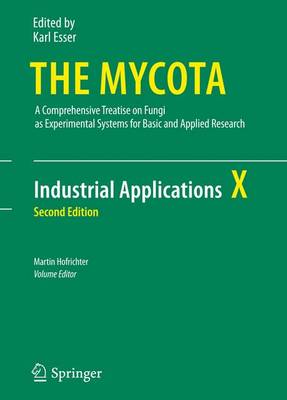(To see other currencies, click on price)
MORE ABOUT THIS BOOK
Main description:
This volume gives a survey of the state of the art in the traditional fields of industrial mycology as well as of selected novel applications of fungi. The first section deals with the use of fungi in the production and processing of bread, cheese, beer and wine, traditional Asian fermentation products and edible mushrooms. The second section is devoted to the production of fungal metabolites and enzymes representing value-added products. In addition to antibiotics, alkaloids organic acids, vitamins and industrial enzymes, which have successfully been in use for decades, it is also dedicated to fungal metabolites, such as insecticidal and nematicidal compounds, immunosurppressants and flavors with promising biotechnological potential. In the next section, the recent developments in fungal biotransformation of small molecules, the bioconversion of lignocelluloses as well as the use of fungi in metal recovery are presented. The final part introduces some innovative new trends in the field of applied mycology: the preparation of fungal bioherbicides, recent genomic approaches for the identification of biopolymer degrading enzymes, current developments in using oxidative enzymes from fungi as well as new attempts to transfer fungal remediation technologies into practice.
Feature:
Continues the excellent concept of the first edition by presenting extensively updated and revised chapters on the production of food and beverages, antibiotics, organic acids, vitamins, and industrial enzymes
Introduces fresh ideas in the form of new contributions dealing with bioherbicides, novel enzymes, flavors, metabolites, and innovative fungal techniques.
Written by experts
Richly illustrated
Contents:
Traditional Food and Beverage Fermentation
1 Production of Bread, Cheese and Meat
KLAUS GORI , METTE DINES CANTOR, MOGENS JAKOBSEN, LENE JESPERSEN
2 Asian Fungal Fermented Food
M.J. ROBERT NOUT, KOFI E. AIDOO
3 Production of Beer and Wine
WINFRIED HARTMEIER, MONIKA REISS
4 Production of Edible Mushrooms
RAMESH CHANDRA UPADHYAY , MANJIT SINGH
Metabolites and Enzymes
5 The β-Lactam Antibiotics: Current Situation and Future Prospects in Manufacture and Therapy
FRANK-RAINER SCHMIDT
6 Non-β-Lactam Antibiotics
GERHARD ERKEL
7 Insecticidal and Nematicidal Metabolites from Fungi
HEIDRUN ANKE
8 Immunomodulators
HESHAM EL ENSHASY
9 Ergot Alkaloids
DANIEL G. PANACCIONE
10 Production of Organic Acids by Filamentous Fungi
CHRISTIAN P. KUBICEK , PETER PUNT , JAAP VISSER3
11 Production of Vitamin B2 and a Polyunsaturated Fatty Acid by Fungi
K.-PETER STAHMANN
12 Fungal Flavours
Marco A. Fraatz , Holger Zorn
13 Industrial Applications of Fungal Enzymes
LARS H. ØSTERGAARD , HANS SEJR OLSEN
Biotransformations, Lignocellulose Conversion and Recovery of Metals from Solution
14 Fungal Biotransformations in Pharmaceutical Sciences
WOLFGANG HÜTTEL , DIRK HOFFMEISTER
15 Fungal Biodegradation of Lignocelluloses
ANNELE HATAKKA , KENNETH HAMMEL
16 (Hemi-)cellulose degrading enzymes and their encoding genes from Aspergillus and Trichoderma
RONALD P. DE VRIES , EVY BATTAGLIA , PEDRO M. COUTINHO , BERNARD HENRISSAT, JAAP VISSER
17 Fungi and their Enzymes for Pitch Control in the Pulp and Paper Industry
ANA GUTIÉRREZ , JOSÉ C. DEL RÍO1, ÁNGEL T. MARTÍNEZ
18 Biosorption of Metals
MARTIN ZIMMERMANN , KLAUS WOLF1
Recent Developments and New Strategies
19 Bioherbicides
ALICE L. PILGERAM , DAVID C. SANDS
20 Genomic approaches for identification of the biopolymer degrading enzyme network of Aspergillus niger
R.M VAN DER KAAIJ , A.F.J. RAM, P.SCHAAP, P.J. PUNT1
21 New Trends in Fungal Biooxidation
MARTIN HOFRICHTER, RENÉ ULLRICH
22 Fungal Soil Bioremediation: Developments Towards Large-Scale Applications
KARI STEFFEN , MARJA TUOMELA
PRODUCT DETAILS
Publisher: Springer (Springer Berlin Heidelberg)
Publication date: October, 2010
Pages: 470
Availability: Not available (reason unspecified)
Subcategories: Biochemistry
From the same series
CUSTOMER REVIEWS
From the reviews:
" ... very good reference volume, which will prove of value to both mycologists and biotechnolgists." (Mycologist)
"Having found a number of the volumes in this series very useful, I was looking forward to reading vol. 10 covering my particular area of interest. I have to say that I found the contents … varied. All the chapters are readable and informative … ." (J. Kelley, Bibliography of Systematic Mycology, Vol. 11 (5), April, 2003)
"This volume of The Mycota contains 21 chapters reviewing the role of fungi in traditional and more recent biotechnologies. ... On the whole, the highly detailed chapters are amply illustrated with figures and tables and provided with detailed bibliographies, and are well written … . will prove of value to both mycologists and biotechnologists." (Brian Flannigan, Mycologist, Vol. 17 (1), 2003)
"The latest volume in this series provides an overview of both traditional and novel industrial applications of fungi from their role in the production of bread, cheese, fermented foods, beer and wines, to their potential in bioremediation. ... it represents a useful source of information for undergraduates as well as their teachers and researchers. Recommended for purchase by academic libraries." (Vicki Tariq, Microbiology Today, Vol. 29, August, 2002)
From the reviews of the second edition:
“This new book … covers the recent development in the industry of fungal world … . this book is good for those interested in industrial application of fungi … . It is also well referenced and updated so the recent development can be clearly viewed from this book. … should be available in all college and university libraries where courses in plant pathology and biotechnology are offered. It is also useful source of information for undergraduates as well as their teachers and researchers.” (Shova Baral, Fungal Diversity, April, 2012)








